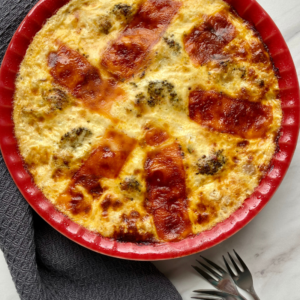One of the best parts of living a Paleo lifestyle is that you get to eat lots of bacon. Now, one misconception about Paleo eating is that all we do is eat bacon all day. Yes, we eat plenty of bacon, but we eat nitrate-free bacon sourced from local pastured pigs, and we eat it in moderation!
I love thickly sliced bacon, and it just keeps giving by providing me with lots of delicious bacon fat! If you’ve been throwing away your bacon fat, STOP! Bacon fat isn’t the enemy. Much of the fat in bacon grease is monounsaturated fat, and a large part of that monounsaturated fat is oleic acid, that same fatty acid that makes olive oil a heart-healthy fat. Besides this fact, bacon fat makes food taste amazing.
Save your bacon drippings in a container in the fridge. Bacon fat lasts for months in the fridge, but I tend to go through it pretty quickly.
Now that we’re all drooling for bacon, it’s time for your Trick:
Some people strain the bacon bits out of the grease, but I like leaving those in. I scoop spoonfuls of bacon fat from that container in the refrigerator and use it for frying eggs, meat and veggies like Brussels sprouts. I even use it when making salad dressing.
Your Tip:
If you make your own Paleo mayonnaise, wait until you try making baconnaise! Mayonnaise is simply a blend of olive oil, egg and lemon. For bacon mayo, swap the olive oil with melted bacon fat at room temperature. This creamy spread is wonderful on burgers!
And your Recipe:

Spinach, Bacon and Mushroom Crustless Quiche
Ingredients
- 1/4 pound bacon cooked and crumbled
- 2 tablespoons bacon fat rendered from cooked bacon
- 1 clove garlic pressed
- 2 cups chopped mixed mushrooms
- 1 pound spinach coarsely chopped, stems removed
- 10 organic cage-free eggs
- 1/2 teaspoon sea salt
- Freshly ground black pepper to taste
- 1/4 cup toasted pine nuts
Instructions
- Preheat oven to 375 degrees.
- Lightly oil a 9-inch pie plate and set aside.
- Cook bacon in large skillet over medium-high heat.
- Remove the fully cooked bacon, crumble and reserve for later.
- Heat the remaining bacon fat in a large skillet over medium-high heat; Add garlic and mushrooms to the remaining bacon fat and cook until mushrooms are golden brown and soft.
- Add the spinach and stir until wilted. Add crumbled, cooked bacon to the mixture. Transfer mixture to the prepared pie plate.
- In a large bowl, beat the eggs, salt and pepper until frothy; pour mixture over mushroom mixture in the pie plate and sprinkle with pine nuts.
- Bake for 35 to 40 minutes, until the top is puffy and brown. Cool slightly then cut into 8 wedges.
- Serve warm or at room temperature.
If you’ve been considering a switch to a Paleo lifestyle, now’s the perfect time to do so! Check out our Paleo Freezer Meal Collection!
4 Responses
Pork in any form is not good for you according to Dr. Josh Axe and nutritionist Emma Deangela , even if it does not have nitrates in it. It contains copious amount of Omega 6 Fatty Acids. Hogs are ususally raised in unsavory conditions and contain many pathogens.
Please cite a reputable source for “contain many pathogens”. Any *particular* pathogens, or just… ‘bad ones’? What does ‘many’ mean to you? Does ‘many’ mean more than in chicken, or beef, or… unwashed lettuce? More than there are living on my hands on a typical day?? Is there any reason we should trust those two particular nutrition experts over the thousands of other ‘nutrition experts’ to be found on the Internet?
Omega-6 fatty acids are considered essential fatty acids: They are necessary for human health but the body can’t make them. I don’t understand what the problem is. Also, while most hogs are raised in unsavory conditions, not all are. That’s where you go for the PASTURED pigs. (PASTURED being the key word.) These are raised in much healthier, less stressful, conditions. Pork is plenty healthy, when eaten in moderation, as with many other meats.
Hummm… my comment disappeared.
I raised pigs for several years. Organically. On pasture– a 2.5 acre alfalfa-grass field… On garden– from which we harvested over 100 lbs of fresh, organic produce daily… And then we planted gardens just for the pigs. They would devour a .25 acre plot in less time than it took us to plant and tend it. On top of all that, each pig (there were 2 sows and 6 weaners) ate a half gallon of organic grain daily.
Now I’m here to tell you that pigs raised on what is today considered “conventional” farms– and worse yet, factory farms eat food that is not fit for anything. The primary feed for pigs is corn and soy– and unless certified organic, you can assume corn and soy are GMO when they’re human food. When it comes to animal food that contains corn, soy, beet pulp (we can soon alfalfa as it was approved as a GMO crop in 2012), it’s 99.9% guaranteed to be GMO. Other grain crops are grown on toxic land or hosed with herbicides just before harvest (to kill weeds so that they don’t gum up the combines). This means your grocery store pork is a toxic waste dump. I mean that quite literally.
Chris Kresser published an article entitled “Why Grass-Fed Trumps Grain-Fed. Although the article speaks to the issue of grain and cattle, you’ll find many of the issues raised here apply to pigs, sheep… even chickens.
My book, Secrets of Soundness: A Manual for Natural Horse and Hoof Care contains two chapters that provide information about toxins “Nutrition and Toxins” and crops, “Pasture Management.” Anyone would benefit from reading these chapters. The book is available on Kindle and will soon be available on Amazon in paperback form too.